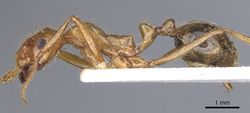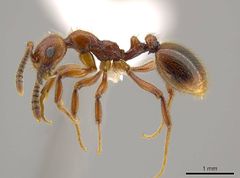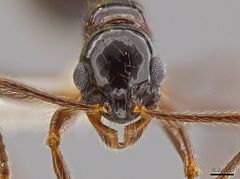Key to Megalomyrmex workers of Central America
This worker key is based on: Boudinot, B.E. Sumnicht, T.P. and Adams, R.M.M. 2013. Central American ants of the genus Megalomyrmex Forel (Hymenoptera: Formicidae): six new species and keys to workers and males. Zootaxa 3732:1-82.
You may also be interested in
Worker-based key to Central American species
Notes: Megalomyrmex reina is not keyed as this species is only known from queens, however the worker is likely to have similar mandibular dentition, as well as the large petiolar and postpetiolar processes. Species of the drifti complex are separated by subtle characters, and thus are difficult to identify; morphometrics are often necessary for a confident determination. Alate queens do not consistently key out.
1
- Mandible with five robust, approximately equal-sized and equally-spaced triangular teeth (fig. 6); large species (ML > 1.0 mm) . . . . . 2
- Mandible with variable dentition: with 3–11 distinct teeth or denticles subtending two larger apical teeth, often varying in size (figs. 7 & 8); if with three roughly evenly-spaced triangular teeth (fig. 7), then teeth varying in size, and body small (ML < 1.0 mm) . . . . . 5

2
return to couplet #1
- Petiolar node narrow, distinct from long, narrow petiolar peduncle (fig. 9). Eye small or large (EL < 0.25 mm, or > 0.30 mm). Propodeum with or without hairy tubercles where dorsal and posterior faces meet . . . . . 3
- Petiolar node broad, indistinct from short, broad petiolar peduncle (fig. 10). Eye large (EL > 0.30). Propodeum without hairy tubercles where dorsal and posterior faces meet . . . . . 4
3
return to couplet #2
- Dorsal face of mandible coarsely striate. Occipital carina obscured by vertex in full-face view. Ocular setae present (best seen against a dark background, fig. 11). Costa Rica to Venezuela . . . . . Megalomyrmex modestus
- Dorsal face of mandible smooth; only interrupted by coarse piligerous puncta. Occipital carina visible in full-face view. Ocular setae absent (fig. 12). Costa Rica south to Andean region . . . . . Megalomyrmex foreli
4

return to couplet #2
- Postpetiolar node robustly globose; anterodorsal and posterodorsal faces convex in profile view (fig. 13). Ocular setae present (best seen against a dark background). Frons with numerous longitudinal, often sinuate carinulae in addition to concentric carinulae around antennal insertions. Costa Rica to Colombia, Guyana, and Amazonian Brazil . . . . . Megalomyrmex wallacei
- Postpetiolar node not globose; anterodorsal face convex, posterodorsal face concave in profile view (fig. 14). Ocular setae absent. Frons without longitudinal carinulae in addition to concentric carinulae around antennal insertions. Panama . . . . . Megalomyrmex milenae
5
return to couplet #1
- Disc of katepisternum with distinct longitudinal carinulae which completely traverse the disc; rugose or not (fig. 15) . . . . . 6
- Disc of katepisternum without distinct longitudinal carinulae; smooth and shining, sometimes with rugosity along posterior mar-gin of disc, or in a portion of the basal half, but this never extending across the width of the disc (fig. 16) . . . . . 11
6
return to couplet #5
- Meso- and metabasitarsi strongly anteroposteriorly compressed, extremely thin in dorsal view (fig. 17) . . . . . 7
- Meso- and metabasitarsi tubular (fig. 18) . . . . . 8
7

return to couplet #6
- Postpetiole width about twice the height in posterior view (fig. 19). Posterior face of postpetiole with fine areolate sculpturation in addition to transverse carinulae (fig. 19). Postpetiolar process in profile view long, fang-like. Malar area covered by longitudinal carinulae. Nicaragua and Costa Rica . . . . . Megalomyrmex fungiraptor
- Postpetiole width slightly greater than height in posterior view (fig. 20). Posterior face of postpetiole smooth and shining in addition to transverse carinulae (fig. 20). Postpetiolar process in profile view short, stout. Malar area largely smooth, not completely covered with longitudinal carinulae. Costa Rica, Panama, and Peru . . . . . Megalomyrmex symmetochus
8
return to couplet #6
- Second or third mandibular tooth from basal margin larger than other basal teeth (fig. 21). Dorsal face of propodeum sloping smoothly to posterior face . . . . . 9
- Second or third mandibular tooth from basal margin subequal in length to other basal teeth (fig. 22). Dorsal face of propodeum meeting posterior face at an angle . . . . . 10
9
return to couplet #8
- Head capsule, promesonotum, petiole and postpetiole covered with rugulose or costate sculpturation (fig. 23). Eye distinctly in anterior half of head, excluding mandibles (fig. 23). Antennae relatively long (SI > 115). Panama . . . . . Megalomyrmex longinoi
- Head capsule, promesonotum, petiole and postpetiole smooth and shining (fig. 24). Eye placed about midlength of head, exclud-ing mandibles (fig. 24). Antennae relatively short (SI < 105). Southern Mexico south to Central Brazil and Peru . . . . . Megalomyrmex incisus
10

return to couplet #8
- Eye large (EL > 0.20 mm), with greater than six ommatidia at maximum diameter. Malar space with at least three strong carinulae extending from lateral margin of mandible to compound eye. Ventrolateral faces of petiole smooth and shining (fig. 25). Larger (ML > 1.0 mm). Panama . . . . . Megalomyrmex adamsae
- Eye miniscule (EL < 0.10 mm), with at most four ommatidia in maximum diameter. Malar space without carinulae. Ventrolateral faces of petiole scabrous (fig. 26). Smaller (ML < 1.0 mm). Costa Rica and Panama . . . . . Megalomyrmex miri
11
return to couplet #5
- Occipital carina visible in full-face view, even if just slightly (fig. 27). Ocular setae present or absent . . . . . 12
- Occipital carina completely obscured in full-face view (fig. 28). Ocular setae present . . . . . 15
12
return to couplet #11
- Antennal insertion encircled by concentric carinulae extending from posterior clypeal margin to frontal carina (fig. 29) and/or scapes, in repose, distinctly exceeding posterior margin of head (SI > 95) . . . . . 13
- Antennal insertion not encircled by concentric carinulae; carinulae extend posteriorly from posterior clypeal margin reaching or passing compound eye medially (fig. 30) and scapes, in repose, barely or not exceeding posterior margin of head (SI < 89) . . . . . 14
13
return to couplet #12
- Postpetiole globose and sternum smoothly bulging (fig. 31). Masticatory margin of mandible with 12 or more miniscule denticles subtending apical two. Foraminal carina present, complete. Scape relatively long (SI > 110). Southern Mexico to northern Argentina; widespread in mainland South America . . . . . Megalomyrmex silvestrii
- Postpetiole anteriorly compressed and sternum dentate anteriorly (fig. 32). Masticatory margin of mandible with 7–10 teeth subtending apical two. Foraminal carina present or absent. Scape relatively short (SI < 105). Costa Rica, Panama . . . . . Megalomyrmex nocarina
14

return to couplet #12
- Occipital carina strongly produced (fig. 33). Temple, in full-face view, evenly and shallowly curved in full-face view (fig. 33). Apical antennomere subequal in length to the preceding two antennomeres. Scape relatively long (SI > 120). Costa Rica . . . . . Megalomyrmex mondabora
- Occipital carina relatively weak (fig. 34). Temple, in full-face view, with strongly rounded angle between posterior and lateral margins (fig. 34). Apical antennomere longer than preceding two antennomeres. Scape relatively short (SI < 114). Costa Rica, Panama, Peru . . . . . Megalomyrmex mondaboroides
15
return to couplet #11
- Eyes miniscule, with at most five ommatidia at maximum diameter (fig. 35). Eye distant from lateral margin of clypeus (OMI > 125, fig. 35). Pedicel about as long as the following three antennomeres. Costa Rica and Panama . . . . . Megalomyrmex wettereri
- Eyes larger, with at least seven ommatidia in maximum diameter (fig. 36). Eye relatively closer to lateral margin of clypeus (OMI < 100, fig. 36). Pedicel about as long as the following two antennomeres . . . . . 16
16
return to couplet #15
- Eyes relatively distant from lateral margin of clypeus (OMI ≥ 61, fig. 37). Dorsal and posterior faces of propodeum meeting at a narrowly rounded or pointed angle, with or without a distinct pointed tubercle. Posterior face of propodeum often with concentric carinulae around foraminal carina. Basal and masticatory margins of mandible distinct . . . . . 17
- Eyes relatively close to lateral margin of clypeus (OMI < 59, fig. 38). Dorsal and posterior faces of propodeum meeting at a broad curve or narrowly rounded angle, without a distinct pointed tubercle. Posterior face of propodeum without concentric carinulae around foraminal carina. Basal and masticatory margins of mandible distinct or indistinct . . . . . 18
17
return to couplet #16
- Setae, especially on first gastric tergum, very coarse. First gastric tergum with few (< 5) short appressed setae. Portion of clypeus between antennal insertions comparatively broad (fig. 39). Foraminal carina incomplete. Costa Rica . . . . . Megalomyrmex brandaoi
- Setae less coarse. First gastric tergum with numerous (> 10) short appressed setae. Portion of clypeus between antennal insertions comparatively narrow (fig. 40). Foraminal carina complete to incomplete. Southern Mexico to Costa Rica; South America; presumably present in Panama . . . . . Megalomyrmex megadrifti
18

return to couplet #16
- Mandible with distinct basal and masticatory margins; margins meet at an angle with or without a denticle (fig. 41). Propodeum rounded dorsolaterally. Scapes longer (SI > 86). Costa Rica . . . . . Megalomyrmex osadrifti
- Mandible with indistinct basal and masticatory margins; margins curve into another and may have minute denticles (fig. 42). Propodeum distinctly marginate dorsolaterally. Scapes shorter (SI < 84). Honduras south to South America; range in South America undetermined . . . . . Megalomyrmex drifti






































